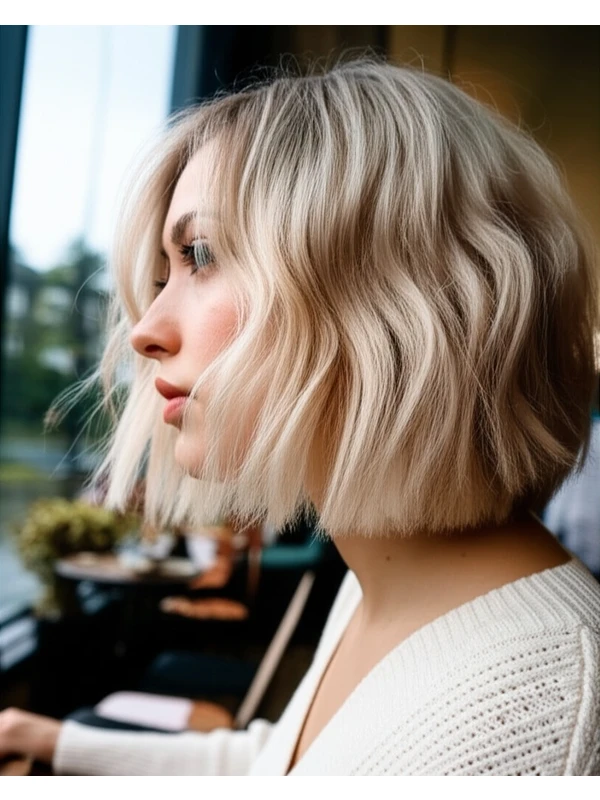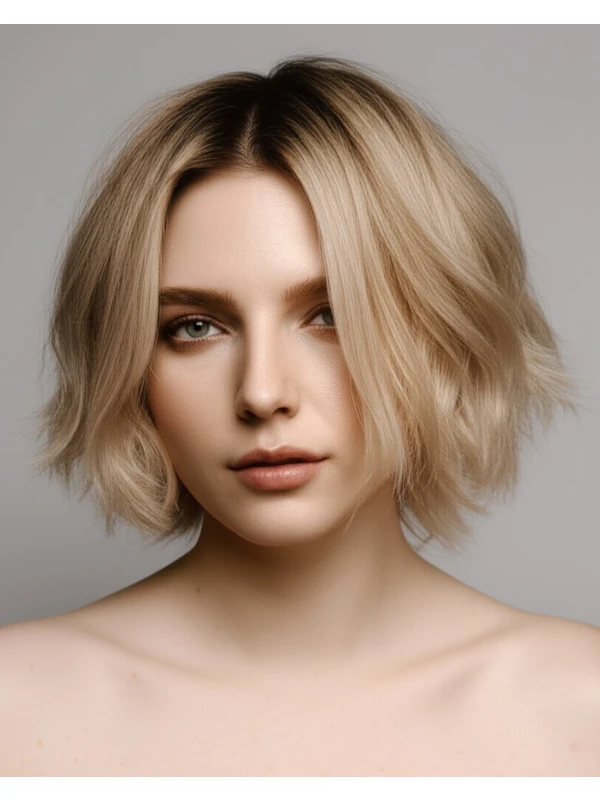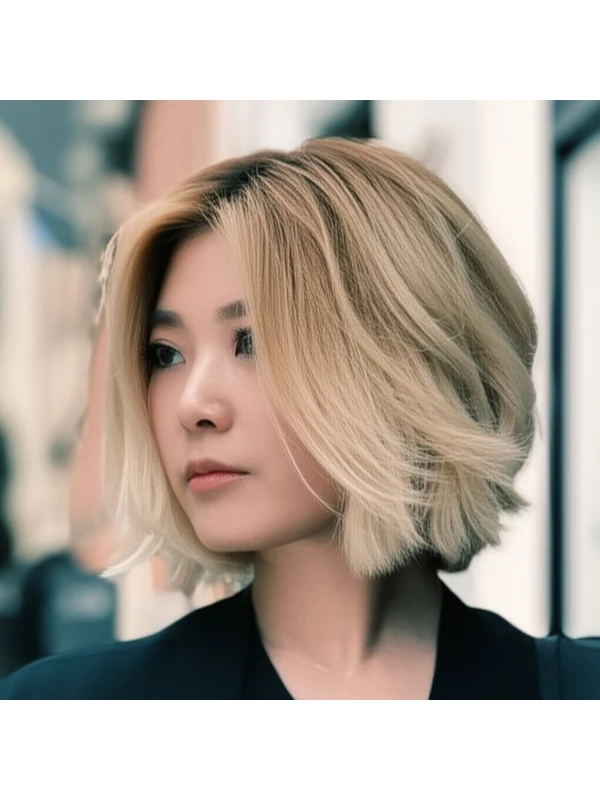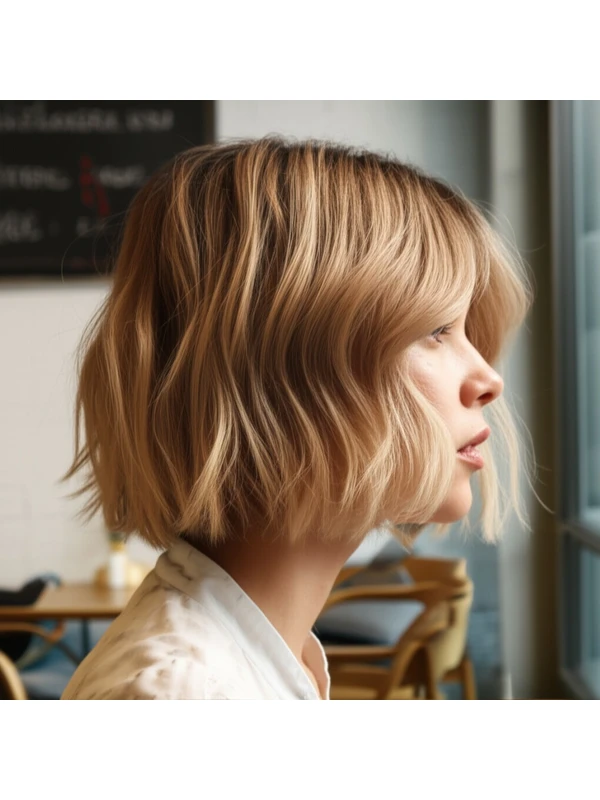#Glass Hair: The Ultimate Guide to a Mirror-Like Finish
The "glass hair" trend is taking over social media, and for good reason! It’s all about achieving an incredibly sleek, reflective finish that looks like… well, glass. But it's more than just shiny hair; the cut itself plays a crucial role. Let's break down everything you need to know to rock this stunning style.
#1) Background & Definition: What is Glass Hair?
Glass hair isn’t just about shine – it’s rooted in a specific haircut geometry and styling technique. The core idea is an incredibly blunt, one-length cut that creates sharp lines and maximizes light reflection. Think of it as a modern take on the classic razor cut, but with even more precision.
Key Features:
- Blunt Ends: No layers or softening – ends are deliberately straight across.
- One Length (Mostly): While subtle variations can work, the overall length is very consistent from front to back. Slightly longer pieces around the face can soften the look if desired.
- Ultra-Smooth Surface: The styling focuses on eliminating any frizz or texture for a truly reflective surface.
- Sharp Lines: The cut and styling work together to create distinct, defined shapes.
Typical Length Ranges: Glass hair can be adapted for various lengths!
- Short: Chin length or slightly shorter (requires very precise styling).
- Medium: Collarbone to shoulder-length (most common and versatile).
- Long: Below the shoulders (can look dramatic but requires significant effort to maintain the sleekness).
Alternative Names: You might also hear this style referred to as "mirror hair," "razor glass hair," or simply “super sleek.”
#2) Face Shape Fit: Finding Your Best Angle
Glass hair's sharp lines can be incredibly flattering, but understanding how it interacts with your face shape is key.
- Oval: Lucky you! Glass hair generally complements oval faces beautifully. The one-length cut emphasizes the balanced proportions. A blunt fringe (more on that below) can add a playful touch.
- Round: A glass hair look can slim down a round face, but length is crucial. Medium to long lengths work best. Avoid chin-length styles which can emphasize roundness. A side part and subtle face framing pieces are your friends!
- Square: The softened lines of glass hair can help soften the angles of a square face. A slightly off-center parting and minimal layering will be most flattering.
- Heart: Glass hair’s sleekness can balance a wider forehead in heart-shaped faces. Longer lengths are generally more flattering than shorter ones. Consider a wispy, side-swept fringe to soften the upper portion of your face.
- Diamond: Similar to heart shapes, glass hair can help create balance for diamond face shapes by softening angles and drawing attention away from prominent cheekbones. A subtle side part is recommended.
Fringe/Bang Options: A blunt, straight-across fringe can work with glass hair but requires serious commitment (and styling!). Side-swept fringes or curtain bangs offer a softer alternative that’s easier to manage.
#3) Body Proportions & Height Guidance: Tailoring the Silhouette
How you carry off glass hair also depends on your overall proportions and height.
- Petite: Medium lengths are generally best for petite individuals, as longer styles can overwhelm the frame. Avoid excessive volume at the roots to prevent a “top-heavy” look.
- Average Height: Glass hair is incredibly versatile for average heights – experiment with different lengths!
- Tall: Longer glass hair looks stunning on taller individuals, creating an elegant and elongated silhouette.
- Narrow Shoulders: Adding subtle volume at the roots (without sacrificing sleekness) can help broaden narrow shoulders. A side part also adds visual width.
- Broad Shoulders: Keep the style streamlined to avoid exaggerating shoulder width. Avoid adding extra volume on top.
- Short Neck: Medium lengths that hit just below the collarbone are often most flattering for those with shorter necks, as longer styles can visually shorten the neck further.
#4) Works Best With Hair Types & Densities: Finding Your Match
Glass hair isn't a one-size-fits-all style! Here’s how it adapts to different hair types and densities.
- Straight: This is the ideal canvas for glass hair. The smooth texture naturally lends itself to the sleek finish.
- Wavy: With careful styling (and potentially a keratin treatment – see disclaimer below), wavy hair can achieve a glass-like appearance, though it requires more effort.
- Curly/Coily: While challenging, glass hair can be adapted for curly and coily textures! The key is to focus on minimizing frizz and creating a unified shape. The cut will likely need to be shorter to avoid excessive bulk.
- Fine Hair: Glass hair can make fine hair appear thicker due to the blunt ends and reflective surface, but it requires strategic layering (or lack thereof) to prevent looking stringy.
- Medium/Thick Hair: The one-length cut works well with medium to thick hair, creating a strong visual impact.
- Density Tips: Those with very dense hair might benefit from subtle internal texturizing within the blunt ends (not layers) to reduce bulk.
Shrinkage Considerations (Curls/Coils): Remember that curly and coily hair shrinks significantly when dry! Factor this into your length decision – what looks like a medium cut wet will appear much shorter dry.
#5) Styling Variations: From Casual Cool to Evening Glam
Glass hair isn't just one look; it’s adaptable for various occasions.
- Sleek vs. Textured: The classic glass hair is ultra-sleek, but you can introduce subtle texture by slightly loosening the ends or adding a bit of bend (while still maintaining shine).
- Middle vs. Side Part: A center part emphasizes symmetry and drama; a side part adds softness and visual interest.
- Fringe Variations: As mentioned earlier, blunt bangs are bold! Curtain bangs offer a softer alternative.
- Occasion Styling: For casual looks, focus on sleekness with minimal product. For office settings, add polish with a refined side part. For evening events, amp up the shine and consider adding subtle accessories like embellished clips or headbands.
#6) Maintenance: Keeping That Glassy Shine
- Trim Cadence: Every 6-8 weeks to maintain the blunt lines.
- At-Home Routine: Focus on hydration and frizz control.
- Heat vs Air Dry: Heat styling is often necessary for achieving the ultimate sleekness, but use it sparingly and always with heat protectant. Air drying can work for some hair types (especially straight hair).
- Product Checklist:
- Hydrating Shampoo & Conditioner
- Leave-in Conditioner or Smoothing Serum
- Heat Protectant (if using heat styling tools)
- Smoothing Styler (creme, oil, or gel - depending on your hair type)
- Finishing Spray for Shine and Hold
- Estimated Daily Styling Time: 20-45 minutes, potentially longer for curly/coily textures.
#7) Grow-Out Roadmap: The Evolution of Glass Hair
- Months 1-3: The initial shape is most dramatic – maintain with regular trims.
- Months 3-6: Ends may start to lose sharpness and frizz can become more noticeable. Focus on deep conditioning and smoothing treatments.
- Beyond 6 Months: Consider subtle adjustments to the cut (e.g., slightly softening face-framing pieces) as it grows out.
#8) Color Pairings: Amplifying the Shine
- Cool Undertones: Ashy browns, cool blondes, and platinum shades enhance the sleekness and reflect light beautifully.
- Warm Undertones: Rich caramels, honey blondes, and copper tones can create a warm glow – just ensure they don’t introduce too much texture or brassiness.
- Low-Commitment Options: Gloss treatments are fantastic for boosting shine without permanent color changes.
#9) Season & Occasion Guide: Adapting to the Moment
- Spring/Summer: A slightly looser, more relaxed version of glass hair works well in warmer weather. Consider a side part and minimal product.
- Fall/Winter: Embrace the sleekness! A center part and heavier styling products create a polished look for cooler months.
#10) Cost & Time: Salon Investment
- Salon Time: Expect around 1.5 - 2.5 hours, depending on hair length and density.
- Price Range: Generally falls in the mid to high-end price bracket – expect a slightly higher salon bill than for simpler styles.
#11) Pros & Cons: The Reality Check
Pros: Incredibly chic, flattering (with proper tailoring), creates visual thickness, highlights hair health. Cons: High maintenance, requires significant styling effort, can be unforgiving if not executed well, potential damage from heat styling.
#12) Salon Consultation Script: Questions to Ask & Discuss
- "I'm interested in the glass hair trend – can you assess if it will work with my hair type and face shape?"
- “How much time do you think I’ll need to dedicate to daily styling?”
- "What products would you recommend for maintaining this style at home?"
- "Can we discuss options for softening the look, especially around my face?"
- "I'm concerned about heat damage – what steps can we take to minimize it?"
#FAQs: Your Burning Questions Answered
- Does glass hair require a keratin treatment? Not necessarily! It depends on your natural texture. Straight and wavy hair may achieve the look with careful styling, while curly/coily hair might benefit from smoothing treatments but these are not essential.
- Can I do this myself at home? With practice and the right tools (a good flat iron is key!), it's possible for some. However, a professional cut will give you the best foundation.
- Is glass hair damaging to my hair? Heat styling can cause damage if not done properly with heat protection. Prioritize hydration and minimize heat exposure whenever possible.
- What’s the difference between glass hair and a razor cut? While both involve blunt ends, glass hair emphasizes an ultra-sleek finish and precise lines, whereas a razor cut often incorporates more texture.
- Can I get glass hair with layers? Generally no – the core of this style is one length. Subtle internal texturizing within the ends can be done for density reasons but visible layers defeat the purpose.
- How do I prevent frizz when styling glass hair? Use a smoothing serum or oil, work in small sections, and ensure your flat iron plates are clean.
**Disclaimer: This article provides general hairstyle and color advice only and should not be considered medical or chemical advice. Always consult with a qualified professional for personalized recommendations.









